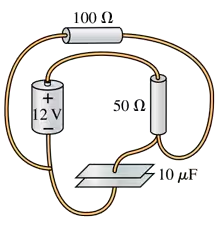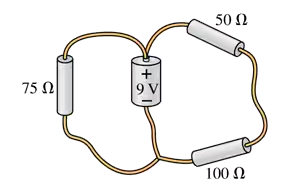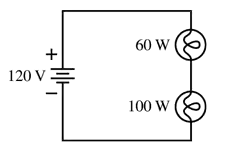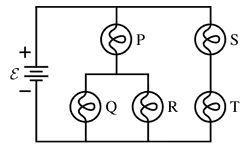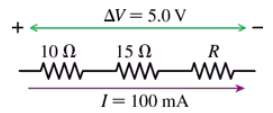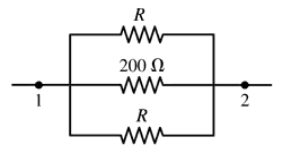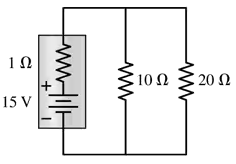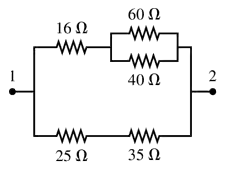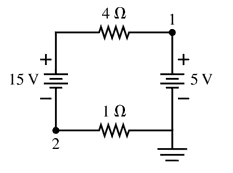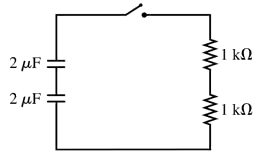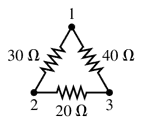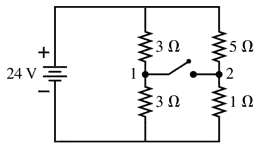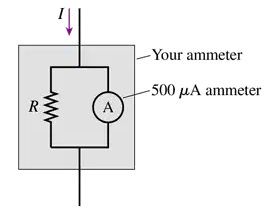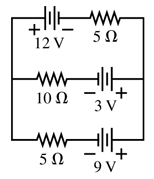 Back
BackProblem 1
Draw a circuit diagram for the circuit of FIGURE EX28.1.
Problem 2
Draw a circuit diagram for the circuit of FIGURE EX28.2.
Problem 6b
Draw a graph of the potential as a function of the distance traveled through the circuit, traveling cw from V = 0 V at the lower left corner.
Problem 9a
A 60 W lightbulb and a 100 W lightbulb are placed in the circuit shown in FIGURE EX28.9. Both bulbs are glowing. Which bulb is brighter? Or are they equally bright?
Problem 11
The five identical bulbs in FIGURE EX28.11 are all glowing. The battery is ideal. What is the order of brightness of the bulbs, from brightest to dimmest? Some may be equal.
Problem 13
A 100 W (120 V) incandescent lightbulb contains a 7.0-cm-long tungsten filament. The high-temperature resistivity of tungsten is 9.0 x 10⁻⁷ Ωm. What is the diameter of the filament?
Problem 14a
A typical American family uses 1000 kWh of electricity a month. What is the average current in the 120 V power line to the house?
Problem 14b
A typical American family uses 1000 kWh of electricity a month. On average, what is the resistance of a household?
Problem 15
Many electric companies use time-of-day pricing in which electricity costs more during hours of high demand. Suppose electricity costs $0.21/kWh from 10 a.m. to 6 p.m.; $0.09/kWh at all other times. What is the annual cost of electricity for a 2.5 kW industrial pump that runs 24 hours a day?
Problem 16
What is the value of resistor R in FIGURE EX28.16?
Problem 17
The voltage across the terminals of a 9.0 V battery is 8.5 V when the battery is connected to a 20 Ω load. What is the battery's internal resistance?
Problem 23
Two of the three resistors in FIGURE EX28.23 are unknown but equal. The total resistance between points 1 and 2 is 75Ω. What is the value of R?
Problem 24
Compared to an ideal battery, by what percentage does the battery's internal resistance reduce the potential difference across the 20 Ω resistor in FIGURE EX28.24?
Problem 27
What is the equivalent resistance between points 1 and 2 in FIGURE EX28.27?
Problem 30
In FIGURE EX28.30, what is the value of the potential at points 1 and 2?
Problem 32
Show that the product RC has units of s.
Problem 34
What is the time constant for the discharge of the capacitors in FIGURE EX28.34?
Problem 37
A capacitor is discharged through a 100 Ω resistor. The discharge current decreases to 25% of its initial value in 2.5 ms. What is the value of the capacitor?
Problem 39
It seems hard to justify spending $5.00 for an LED lightbulb when an ordinary incandescent bulb costs 50¢. To see if this makes sense, compare a 60 W incandescent bulb that lasts 1000 hours to a 10 W LED bulb that has a lifetime of 15,000 hours. Both bulbs produce the same amount of visible light. If electricity costs $0.15/kWh, what is the total cost—purchase price plus energy—to get 15,000 hours of light from each type of bulb? This is called the life-cycle cost.
Problem 42
An electric eel develops a 450 V potential difference between its head and tail. The eel can stun a fish or other prey by using this potential difference to drive a 0.80 A current pulse for 1.0 ms. What are (a) the energy delivered by this pulse and (b) the total charge that flows?
Problem 43
You have a 2.0 Ω resistor, a 3.0 Ω resistor, a 6.0 Ω resistor, and a 6.0 V battery. Draw a diagram of a circuit in which all three resistors are used and the battery delivers 9.0 W of power.
Problem 44
A 2.0-m-long, 1.0-mm-diameter wire has a variable resistivity given by where x is measured from one end of the wire. What is the current if this wire is connected to the terminals of a 9.0 V battery?
Problem 45a
To which two points in the circuit of FIGURE P28.45 should a 12 V battery be connected to dissipate the most power?
Problem 47b
A small toaster that operates at 120 V has a heating element made from a 4.4-m-long, 0.70-mm-diameter nichrome wire. The resistivity, density, and specific heat of nichrome are, respectively, 1.5 x 10⁻⁶ Ωm, 8400 kg/m³, and 450 J/kg K. If half the heat energy is lost to the air, how long does it take the heating element to warm from 20℃ to 450℃, about the temperature at which it first begins to glow red?
Problem 49
Suppose you have resistors 2.5 Ω, 3.5 Ω, and 4.5 Ω and a 100 V power supply. What is the ratio of the total power delivered to the resistors if they are connected in parallel to the total power delivered if they are connected in series?
Problem 50
A lightbulb is in series with a 2.0 Ω resistor. The lightbulb dissipates 10 W when this series circuit is connected to a 9.0 V battery. What is the current through the lightbulb? There are two possible answers; give both of them.
Problem 51a
Load resistor R is attached to a battery of emf and internal resistance r. For what value of the resistance R, in terms of ∈ and r, will the power dissipated by the load resistor be a maximum?
Problem 55
What are the battery current Ibat and the potential difference V₁ - V₂ between points 1 and 2 when the switch in FIGURE P28.55 is (a) open and (b) closed?
Problem 56b
A circuit you're building needs an ammeter that goes from 0 mA to a full-scale reading of 50 mA. Unfortunately, the only ammeter in the storeroom goes from 0 μA to a full-scale reading of only 500 μA. Fortunately, you've just finished a physics class, and you realize that you can make this ammeter work by putting a resistor in parallel with it, as shown in FIGURE P28.56. You've measured that the resistance of the ammeter is 50.0 Ω, not the 0 Ω of an ideal ammeter. What is the effective resistance of your ammeter?
Problem 61
What is the current through the 10 Ω resistor in FIGURE P28.61? Is the current from left to right or right to left?

